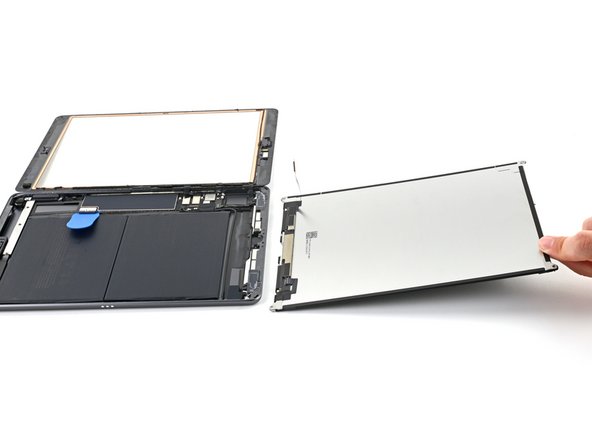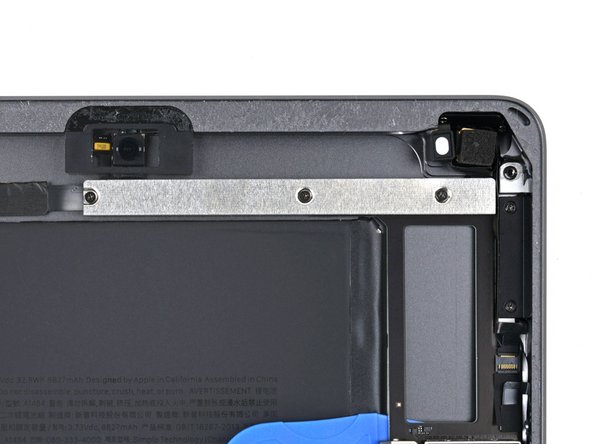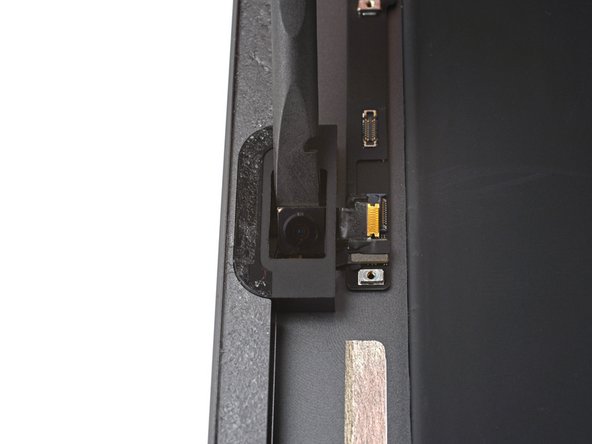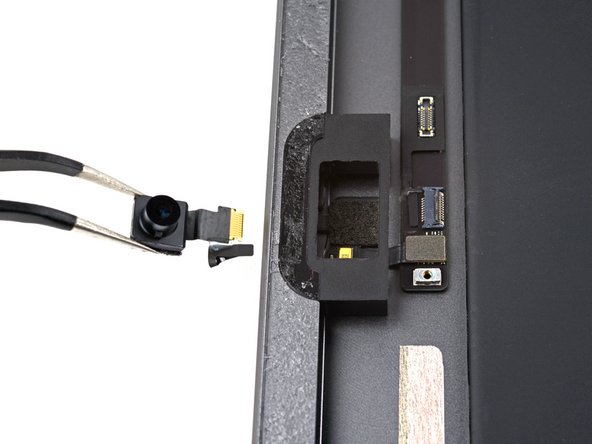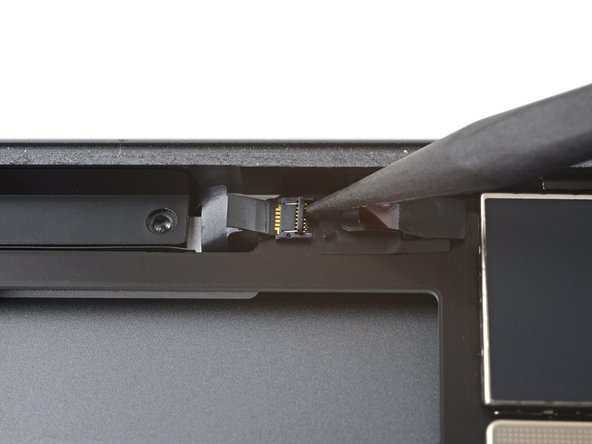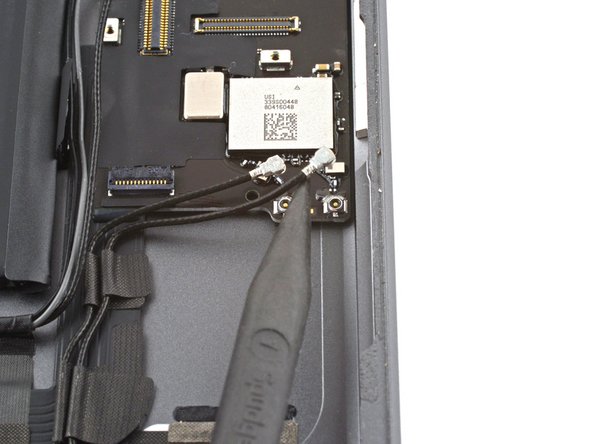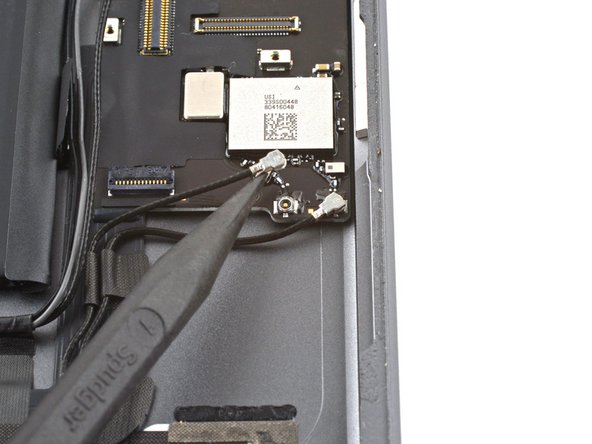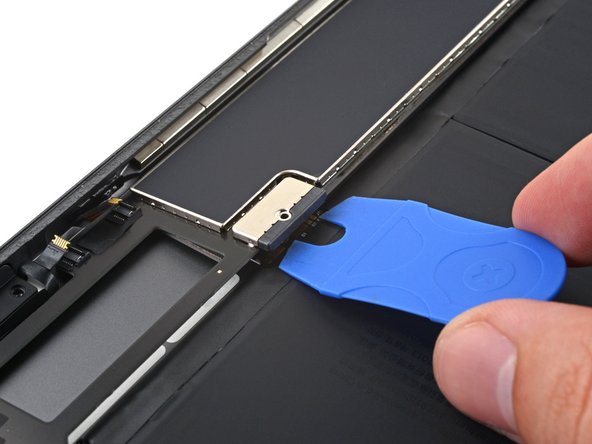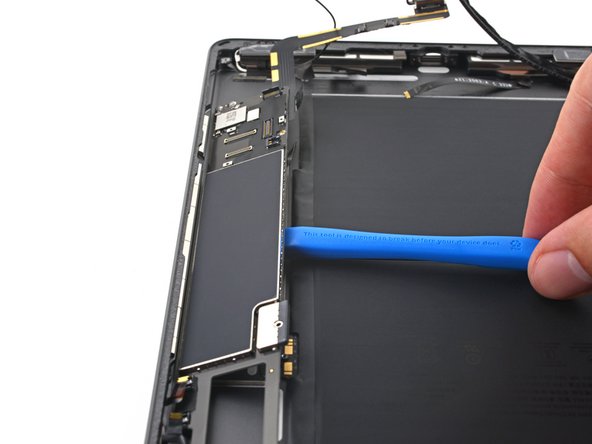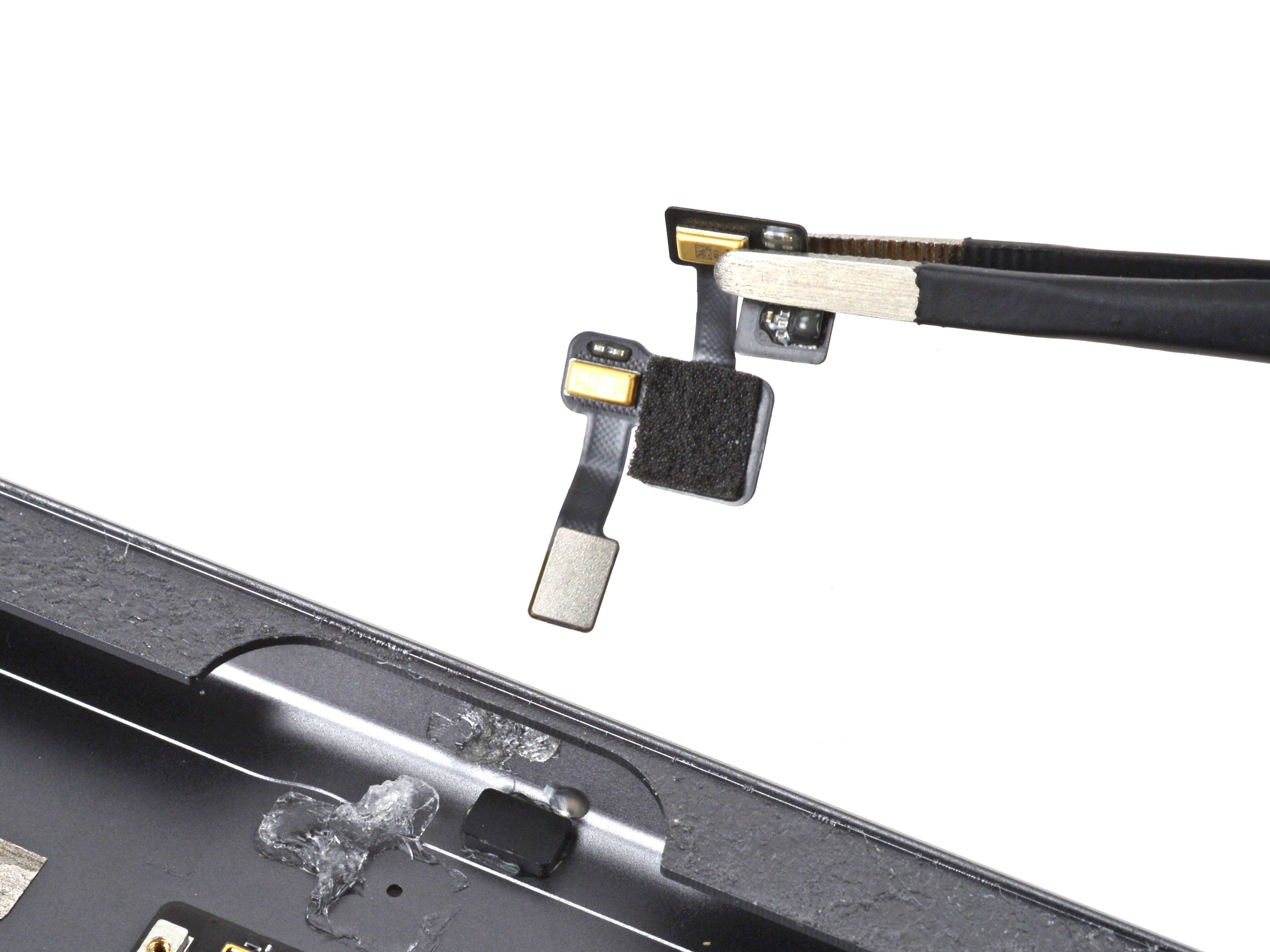iPad 9 Battery Replacement
Duration: 45 minutes
Steps: 110 Steps
Heads up! Make sure your iPad's battery is below 25% before you start taking it apart—safety first, so no sparks fly!
Follow this guide to swap out the battery in your iPad 9 Wi-Fi model. Heads up: this is only for the Wi-Fi version; if you have the LTE model, check the appropriate guide instead. For safety’s sake, make sure your battery is drained below 25% before you start taking things apart—this lowers the chance of fire if the battery gets damaged. If your battery looks swollen, be extra cautious. When disconnecting the battery with a battery blocker, handle it gently—those contacts are delicate and can be ruined easily. If you decide not to isolate the battery, try to avoid using metal tools unless absolutely necessary (like when loosening screws) to prevent short circuits and protect sensitive parts. Some pictures might be from a slightly different model, but that won’t throw off the steps here.
Step 1
Make sure to turn off your iPad before diving into the repair adventure!
- Warm up an iOpener and chill it on the left edge of your iPad for a solid two minutes to soften things up.
Tools Used
Step 2
- As you let that adhesive take its sweet time loosening up, keep an eye out for these sensitive spots that are a bit touchy when it comes to prying:
- Front camera
- Antennas
- Display cables
- Ambient light sensors
Step 3
Get ready for the next three steps where we introduce the Anti-Clamp, a nifty little tool we created to make opening your device a breeze. If you're not using the Anti-Clamp, no worries! Just skip ahead three steps for a different approach.
Want to master the Anti-Clamp? Check out our handy guide for all the tips and tricks!
Is your iPad's surface feeling a bit too slick for the Anti-Clamp to grip? No problem! Just slap on some tape for a better hold.
- Slide the blue handle back to release the Anti-Clamp's arms.
- Set something under your iPad so it stays balanced and level between the suction cups.
- Place the suction cups close to the center of the left edge—one near the top and the other near the bottom.
- Keep the bottom of the Anti-Clamp steady while pressing down firmly on the top cup to create suction.
Step 4
- Give the blue handle a gentle tug forward to secure those arms in place.
- Twist that handle a full 360 degrees, or until you see the cups start to stretch a bit.
- Keep an eye on those suction cups! They should stay lined up nicely. If they start to wander off course, just loosen them a tad and realign the arms like a pro.
Step 5
Take it easy with the turning – just a half-turn at a time. Give it a minute to settle before you try again. Let the Anti-Clamp and a little patience do their magic.
Want the full scoop on using a hair dryer like a pro? Dive into this guide.
If the Anti-Clamp isn’t opening enough of a gap, just heat it up a bit more and give the handle a half turn clockwise.
- Give it a minute to let the adhesive chill out and create a little gap for you to work with.
- If your screen’s not warming up enough, grab a hair dryer and gently heat along the left edge of the iPad to help things loosen up.
- Once the Anti-Clamp has made a big enough gap, slide an opening pick under the digitizer to get things moving.
- Skip the next step.
Step 6
In this step, we're going to show you how to crack open your iPad using a trusty suction handle.
If your screen’s looking more like a spider web than a display, don’t stress! Stick a layer of clear packing tape over the cracks to help the suction cup cling on. If you're feeling bold, grab some extra-strong tape instead of the suction cup. And if nothing seems to work, you can always try supergluing the suction cup right onto the shattered screen. Whatever it takes to get that baby open!
- Once the screen feels nice and toasty, grab a suction handle and stick it near the left edge—right up close to the border.
- Gently lift the screen with the suction handle just enough to peek a small gap between the digitizer and the frame.
- Slide an opening pick into that tiny gap to start prying the digitizer away from the frame.
Tools Used
Step 7
No need to stress if the opening pick peeks through the digitizer — just wiggle it out gently. Your LCD should be safe, but be mindful of sticky adhesive that can be a bit tricky to clean up.
- Pop a second opening pick into the gap you just made.
- Slide that pick towards the bottom-left corner of your iPad to break free the adhesive.
- Keep the pick in place at the bottom-left to make sure the adhesive doesn't come back for a second attempt.
Step 8
- If your opening pick gets stuck in the adhesive, no worries—just gently roll it along the edge of the iPad to keep peeling that sticky stuff away.
Step 9
- Gently slide your first opening pick into the top-left corner of the iPad to break through that stubborn adhesive.
- Once it's in place, leave the pick in the corner so the adhesive doesn't decide to play it cool and seal itself back up.
Step 10
- Warm up an iOpener and press it gently against the top edge of your iPad for two minutes.
Tools Used
Step 11
- Gently maneuver the pick around the top-left corner of the iPad to break free the adhesive. Keep it light and cheerful, and you'll be peeling that away in no time!
Step 12
Be careful not to slide the pick over the front camera—you don’t want to risk damaging that lens! The steps ahead will show you how to avoid that little mishap.
- Gently glide the opening pick along the top edge of the iPad, but hold up just shy of the front camera. You've got this!
Step 13
- Gently pull the pick out, leaving just the tip tucked between the digitizer and the frame.
- Carefully slide the pick above the front camera to break the adhesive bond.
- Keep the pick near the right side of the front camera before you move on. You're almost there!
Step 14
- Slide the pick back in and gently glide it towards the top-right corner of the iPad to fully loosen the top adhesive.
- Keep the pick lodged in the top-right corner so the adhesive doesn’t sneak back together.
Step 15
- Warm up that iOpener and give the right edge of your iPad a cozy two-minute hug.
Tools Used
Step 16
- Gently rotate the pick around the top-right corner of the iPad to start loosening the adhesive. Take your time and let the pick work its magic.
Step 17
The display cables hang out about halfway up from the bottom of your iPad. When you’re sliding in there, pause once you hit around 3 inches from the bottom to avoid any surprises.
- Grab a fresh opening pick and gently slide it halfway along the right edge of your iPad.
Step 18
- Warm up an iOpener and press it against the bottom edge of your iPad for a couple of minutes to loosen things up.
Tools Used
Step 19
Avoid spinning the pick all the way around the corner to keep the antenna safe and sound.
Take a look at the third image—it shows the bottom-left antenna hiding under the digitizer. It's a little sneaky, but nothing you can't handle!
- Gently slide the bottom-left pick towards the corner, separating the adhesive as you go.
- Keep the pick in place at the corner before jumping to the next step.
Step 20
Keep the pick sliding only toward the home button—going the other way might mess up the antenna, and we don’t want that!
If you need to glide the pick over this spot again, just pull it out and pop it back in at the bottom-left corner to keep things smooth.
- Gently slide a fresh opening pick into that gap you just made at the bottom edge of the iPad.
- Now, carefully glide the pick over the antenna, but stop just before you hit the home button.
- Leave the pick hanging a little to the left of the home button before you keep going.
Step 21
- Start by slipping your opening pick into the little gap you've made.
- Now, gently slide the pick under the home button and move it towards the bottom-right corner, just enough to get the tip between the digitizer and the frame.
Step 22
Just a friendly reminder: slide that pick gently towards the home button, not away! We wouldn’t want to accidentally give your antenna a rough day.
If you find yourself needing to slide the pick over this spot again, just take it out and pop it back in at the bottom-right corner. Easy fix!
- Pop that pick back in and give it a gentle slide toward the home button to fully break free the bottom adhesive. You're doing great!
- Now, just leave that pick hanging out to the right of the home button before moving on. Keep up the good work!
Step 23
- Warm up an iOpener and place it on the right edge of the iPad for a cozy two minutes.
Tools Used
Step 24
Take it slow and steady here. Make sure the adhesive is nice and warm so it’s easy to handle, and carefully separate all of it with a pick. If you need to, pause and reheat—no rush!
If you're feeling some serious resistance, just warm up those edges again and glide along with your trusty opening pick.
- Gently twist those opening picks into the left corners of your iPad. This will help lift the digitizer just a bit, making it easier to break free from any remaining adhesive. You've got this!
Step 25
During the rest of the steps, be careful not to smudge the glass or the LCD surface with your fingers—those fingerprints can be a real pain to clean off.
- Gently lift the left edge of the digitizer to start loosening the adhesive along the right edge of the iPad. This will make it easier to separate the parts.
Step 26
Handle those two digitizer cables with care while using your opening pick—let's keep them safe and sound!
- Keep a steady hand on the digitizer while gently sliding an opening pick between the two digitizer cables to carefully break apart the last bit of stubborn adhesive.
Step 27
- Once you've successfully parted ways with all that pesky adhesive, gently open the digitizer like a captivating book and lay it down beside the iPad with a friendly flourish.
- As you gear up for reassembly, take a moment to tidy up by cleaning off any leftover adhesive from the frame—and from the digitizer if you're giving it a second chance—using some isopropyl alcohol. Don't forget to swap out that old adhesive with our handy adhesive strips or those nifty pre-cut adhesive cards.
- Keep an eye on those display cables during the reassembly dance! Ensure they're snugly tucked away beneath the LCD screen to avoid any mishaps. You've got this!
Step 28
- Grab your trusty Phillips screwdriver and unscrew those four 4.2 mm-long screws that are holding the LCD snugly to the frame. You've got this!
- As you work through this repair, keep an eye on each screw and remember where it belongs. This will help prevent any mishaps with your iPad.
- Take a moment to peel away any tape that might be hiding those LCD screws. Let's give them some room to shine!
Step 29
Hold off on pulling the LCD all the way out just yet—it's still hanging on by a few cables near the home button side.
Gently lift the LCD starting from the front-facing camera end only.
- Gently wedge the flat end of a spudger under the LCD just enough to loosen it so you can get a good grip with your fingers.
- Carefully flip the iPad LCD over like turning a page in a book, lifting near the camera and swinging it around the home button side of the frame.
- Place the LCD face down on a clean, soft, lint-free surface to give yourself easy access to the display cables.
Tools Used
Step 30
- Grab your Phillips screwdriver and carefully unscrew the tiny 2.3 mm screw that’s holding the battery connector onto the logic board. Keep it safe!
Step 31
Check out these photos to see what the battery connector looks like beneath the logic board. Keep them handy as you carefully disconnect the battery.
You'll notice the battery connector is equipped with cantilever springs that press into the battery's contact pads. Since both the logic board and battery are glued down, you'll need something thin and flexible to gently separate the two and disconnect the battery.
Step 32
Take your time and follow the steps closely when isolating the battery with a battery blocker. Those battery contacts are delicate little guys—bend or break them, and it’s game over for your device.
Make sure the logo on the battery blocker is facing up — that’s the right side up, promise!
Take it easy when sliding the battery blocker under the connector. No need to Hulk-smash it. If it’s being stubborn, a playing card can gently nudge the battery loose instead.
Ideally, the battery blocker or playing card should slip under the logic board like butter. Once in, let it chill at about a 15-degree angle and you’re golden.
- Gently slide the battery blocker under the logic board's battery connector at about a 35 degree angle—smooth and steady wins the race.
- Keep the battery blocker right where it is while you continue working to keep things safe and sound.
Tools Used
Step 33
- Grab your trusty Phillips screwdriver and get ready to unscrew three tiny 1.4 mm-long screws that are holding down the display cable bracket. You've got this!
Step 34
- Time to say goodbye to that display cable bracket! Gently remove it and set it aside for now. You’re one step closer to success!
Step 35
- Grab your trusty spudger and use the flat end to gently pry up and disconnect that LCD cable press connector. Easy peasy!
- When it's time to reattach those press connectors, take a moment to line them up just right. Press down on one side until you hear that satisfying click, then do the same on the other side. Remember, no pressing in the middle! If things get misaligned, you could bend some pins, and we definitely don’t want that. Stay careful!
Tools Used
Step 36
- Gently lift off the LCD and place it face down on a clean, soft surface that’s free of lint. Make sure it has a cozy spot to rest while you move on to the next step.
Step 37
- Grab a trusty pair of tweezers and gently peel away the tape that's keeping the home button cable ZIF connector under wraps. You're almost there!
Tools Used
Step 38
- Grab a spudger, opening tool, or even your trusty fingernail, and gently flip up the small, hinged locking flap on the home button cable ZIF connector. You're almost there!
Tools Used
Step 39
- Grab a pair of tweezers and gently pull the home button ribbon cable straight out of the ZIF connector. No need to rush—take your time and make sure it comes out smoothly.
Tools Used
Step 40
Hey there! Just a friendly reminder to be gentle with your iPad: stick to prying only on the connectors, and give the socket on the logic board a break. Your device will thank you for it!
- Grab your trusty spudger and use the flat end to carefully pry up and disconnect those two digitizer cable press connectors. Easy does it—keep it steady and you'll be good to go!
Tools Used
Step 41
Watch out—don't poke or rip the home button ribbon cable!
- Grab your trusty spudger and gently wiggle the flat end underneath the buffer block in the bottom-right corner of your iPad. Time to give it a little lift!
- Once you've got it pried up, go ahead and pop that buffer block right out!
Tools Used
Step 42
The home button cable is lightly held in place with a bit of adhesive. Nothing too tough to handle!
- Grab your tweezers and gently lift the home button cable off the frame like a pro.
Tools Used
Step 43
Grab an opening pick and gently slice through any leftover adhesive still holding the front panel assembly to the frame—smooth moves here make all the difference.
Keep in mind, without proper insulation, parts of the digitizer might short-circuit against other components, leading to funky touch issues.
This insulation is sneakier than you think—it's invisible to the naked eye and not the same as the foam dust barriers you’ve seen on many iPads.
- First things first, let’s get that front panel assembly off! You've got this!
- If your new display is acting a bit quirky with 'ghost' or 'phantom' touch inputs, no worries! Simply add a layer of super thin insulating tape, like Kapton (polyimide) tape, to the highlighted areas on the back of the panel. But don’t sweat it—most replacement digitizers come with the right insulation already, so tape might not even be necessary!
- Now, as we get ready to put everything back together, make sure to clear away any leftover adhesive from your iPad. Grab some high concentration isopropyl alcohol (90% or higher) and a lint-free cloth to give those glued areas a good clean. This will prep your iPad perfectly for the new adhesive and ensure a solid bond.
- Finally, give your iPad a quick function test and apply those pre-cut adhesive strips to the back of the display using our display adhesive application guide before sealing it up tight. And remember, if you run into any tricky spots, you can always schedule a repair!
Step 44
- Grab a Phillips screwdriver and twist out the three tiny 1.4 mm screws holding the upper component bracket in place.
Step 45
- Grab some tweezers or just your fingers and gently lift that upper component bracket off the frame.
Tools Used
Step 46
- Gently remove any tape that’s hiding the left ambient light sensor's ZIF connector. Let’s give that little guy some breathing room!
Step 47
- Gently use the tip of a spudger, an opening tool, or even your fingernail to lift up the tiny hinged locking flap on the left ambient light sensor’s ZIF connector. Take it slow, you’ve got this!
Tools Used
Step 48
- Grab your trusty pair of tweezers and gently slide the left ambient light sensor cable out of the ZIF connector. Take it slow and steady, it’ll pop right out!
Tools Used
Step 49
The left ambient light sensor is gently stuck to the frame, so take your time peeling it off.
- Gently grab the sensor with your tweezers or fingers, and carefully lift it out of the frame.
Tools Used
Step 50
- Grab those tweezers and gently lift off any stubborn adhesive that's still clinging to the frame. You got this!
Tools Used
Step 51
- Gently peel away any tape that's covering the headphone jack's press connector.
Step 52
- Gently slide the flat end of the spudger under the headphone jack connector and lift it up to disconnect it. You've got this!
Tools Used
Step 53
The headphone jack cable is gently stuck to the frame, so give it a little nudge to release it.
- Grab some tweezers (or your trusty fingers) and gently lift the headphone jack cable away from the frame. Keep it smooth and steady—this part's easy, like peeling a sticker off a new phone case.
Tools Used
Step 54
- Grab your trusty Phillips screwdriver and unscrew that 3.3 mm-long screw holding the headphone jack snugly in place. You're doing great!
Step 55
- Grab a pair of tweezers and gently pull the headphone jack out of its cozy little home. It's time for it to come out and say goodbye!
Tools Used
Step 56
- Gently remove any tape that's covering the front camera's ZIF connector. It should peel off easily – no need for a struggle here!
Step 57
- Grab your trusty spudger, an opening tool, or even your fingernail, and gently lift that tiny hinged flap on the front camera's ZIF connector. It’s like a mini treasure hunt, but with tools!
Tools Used
Step 58
- Grab your tweezers and gently pull the front camera cable straight out from the ZIF connector—nice and steady wins the race!
Tools Used
Step 60
If you're having a tough time breaking that adhesive seal, crank up the heat a bit and give it a go from different angles. You've got this!
- Slide the flat end of your trusty spudger between the front camera and the frame with a gentle touch.
- Carefully lift up to break the adhesive seal and give your device a little wiggle.
Tools Used
Step 61
- Gently coax the front camera out of its cozy little nook using your trusty tweezers.
Tools Used
Step 62
- Gently pry up the rear camera’s press connector using the flat end of a spudger to safely disconnect it.
Tools Used
Step 63
- Gently lift and remove any tape that’s hiding the button control cable ZIF connector.
Step 64
- Carefully use the tip of a spudger, an opening tool, or your trusty fingernail to lift up the small, hinged locking flap on the ZIF connector for the button control cable. You've got this!
Tools Used
Step 65
- Grab a trusty pair of tweezers and gently coax that button control cable right out of the ZIF connector. You've got this!
Tools Used
Step 66
- Gently remove any tape covering the Smart Cover sensor cable ZIF connector. It’s a simple step, just be careful not to pull anything too hard.
Step 67
- Gently use the tip of a spudger, an opening tool, or even your trusty fingernail to lift up that little hinged locking flap on the Smart Cover sensor cable ZIF connector. You've got this!
Tools Used
Step 68
- Grab your tweezers and gently wiggle the Smart Cover sensor cable straight out from the ZIF connector—easy does it!
Tools Used
Step 69
- Grab the tip of your trusty spudger and gently pry up to disconnect the coaxial cable for the left antenna. Easy peasy!
- Now, do the same for the right antenna's coaxial cable. You're doing great!
- When it's time to put everything back together, these little connectors can be a bit of a puzzle. Just hold each connector above its socket and give it a gentle press with the flat end of your spudger. You'll hear a satisfying snap when it clicks into place. You've got this!
Tools Used
Step 70
Handle the antenna cable by its body, not the connector. Yanking on the connector could break it, and we don't want that! Keep it gentle, and your repair will go smoothly.
- Gently lift the right antenna cable up and away.
Step 71
- Gently lift the left antenna cable off the frame, following along the bottom edge of your iPad.
Step 73
- Grab a pair of tweezers or your trusty fingernail and gently lift up the tape that's keeping the speaker connectors in place. Nice and easy, you got this!
Tools Used
Step 74
- Gently use the tip of a spudger, an opening tool, or even your fingernail to lift up the tiny, hinged locking flap on both the left and right speaker cable ZIF connectors.
Tools Used
Step 75
- Grab a pair of tweezers and gently pull the left and right speaker cables straight out of their ZIF connectors. Just take your time and be careful with those cables—no rush!
Tools Used
Step 76
- Grab your trusty spudger and use its pointed end to gently pry up the Smart Connector coaxial cable. Aim to get as close to the connector as possible for a smooth disconnection!
Tools Used
Step 77
- Grab your trusty spudger and gently lift the Smart Connector cable's connector. Disconnect it like a pro!
Tools Used
Step 78
- Grab a pair of tweezers and gently lift the tape holding the Smart Connector cables in place on the frame. Easy does it!
Tools Used
Step 79
- Gently lift the Smart Connector cables off the frame, like peeling a sticker without the sticky mess.
Step 80
- Grab your trusty Phillips screwdriver and let's get those four screws out that are holding the charging port to the frame:
- Two screws measuring 1.8 mm in length
- Two screws measuring 3.2 mm in length
Step 81
- Warm up that iOpener and give it a cozy hug to the bottom, top, and logic board side of your iPad for a solid thirty seconds at each spot. You're doing great!
Tools Used
Step 82
- Slide an opening pick beneath the charging port cable close to the charging port and glide it toward the logic board to break the adhesive seal.
Step 83
- Gently wiggle the charging port free from its cozy spot in the frame.
Step 84
- Slide an opening pick under the upper arm of the logic board and gently glide it toward the board to slice through the adhesive holding it to the frame.
- Keep that opening pick in place to prevent the adhesive from sticking back together.
Step 85
- Gently take out the battery blocker. It's usually a small piece that keeps things secure. Just pop it out and you're good to go!
Tools Used
Step 86
Bending or warping the logic board can spell trouble for your device. If the adhesive is being particularly stubborn, don't hesitate to apply a bit more heat and give it another go!
If the logic board seems stuck, carefully slide an opening pick under the bottom edge to gently cut through some of the adhesive holding it in place.
- Grab an opening tool and gently slide it in near the center of the logic board. Apply a little pressure to carefully lift it away from the frame, making sure to keep things smooth and steady. No rush here—just give it a nice, controlled peel!
Step 87
- Grab a halberd spudger or an opening pick and carefully slice through any stubborn adhesive still holding the logic board to the frame. Take your time—this part can be tricky, but you’ve got this!
Tools Used
Step 88
- First things first, let's get that logic board out of there! It's the heart of your device, and it's time for it to shine on its own.
- As you put everything back together, keep an eye out for any sneaky ribbon cables trying to hide under the logic board. Make sure they're all out in the open before you seal the deal with some glue.
- If the original adhesive is giving you a tough time and looks a bit worse for wear, no worries! Just grab some strips of Tesa tape to hold everything in place during reassembly. You've got this!
Step 89
Before you yank out the battery, slap some tape over the other bits in the back to keep them safe and sound.
Give the tape's bottom edge a good rub with your finger to make sure it sticks tight.
- Cut a piece of painter's or scotch tape that’s the same width as your iPad.
- Stick the bottom edge of the tape strip above the speakers and bottom antennas on the rear case.
- Now, place the top edge of the tape over the bottom components to keep any pesky cables from sneaking into the battery removal area.
Step 90
- Grab some trusty tape and cover those upper components like a pro!
Step 91
Heads up! The adhesive remover contains acetone, which can be a bit rough on your skin and eyes, so handle with care.
- Make sure to rock some eye protection while you're handling and applying that adhesive remover. Safety first, right?
- If you wear contact lenses, it's a good idea to keep those peepers protected with some stylish eye gear.
- Don't forget, your kit comes with protective gloves! If you're a bit worried about your skin, go ahead and slip those gloves on now.
Tools Used
Step 92
Give that bottle cap a twist to loosen it up or pop it off before you snip the applicator tip. You're doing great!
Once you're ready to roll, make sure to twist the bottle cap back on tight. You've got this!
Unsealing the bottle is the first step to success! This lets the pressure balance out before you snip the applicator tip. Skip this, and you might get an unexpected adhesive remover surprise when you cut the tip!
By cutting closer to the narrow tip, you’ll gain better control, allowing you to apply the adhesive remover in just the right amount. Go for precision!
- Time to get that black rubber stopper off your adhesive remover bottle! Give it a gentle tug and watch it come off like magic.
- Grab those scissors and snip off the sealed tip of the applicator. You're doing great, keep it up!
Step 93
- Check out the red boxes for the spots where those sneaky adhesive strips are hiding, keeping the battery snug against the rear case.
Step 94
- Gently apply a few drops of adhesive remover or some strong isopropyl alcohol along the left edge of the battery. This will help loosen things up without making a mess.
Step 95
- Pour a few drops of adhesive remover or some high-concentration isopropyl alcohol right along the bottom edge of that battery. Let's get that sticky situation sorted out!
Step 96
- Squeeze a couple of drops of adhesive remover or high-concentration isopropyl alcohol between those battery cells. It'll loosen things up nicely!
Step 97
- Gently drip a few drops of adhesive remover or some strong isopropyl alcohol along the battery's right edge to help loosen things up.
Step 98
- Drop a little adhesive remover or some strong isopropyl alcohol right along the top edge of the battery to help loosen things up.
Step 99
Heads up! Be super gentle with the battery—avoid poking or bending it with your tool. A damaged battery could spill some nasty chemicals or even cause a thermal flare-up. Safety first!
If you hit a stubborn patch where the adhesive just won’t budge, pop on an iOpener to that spot and give it some heat love.
- Slide a plastic card gently into the bottom right corner of the battery to get things moving.
Tools Used
Step 100
- Gently slide that plastic card under the right edge and make your way to the center like a pro.
- Wedge the plastic card in as deep as it can go under the battery to break that adhesive bond.
- Carefully pull out the plastic card, and you're one step closer to success!
Step 101
- Slide that plastic card right under the battery connector as far as it'll go. Keep pushing until you can’t push any further.
- Leave the card in place – it’ll be holding things steady while you move to the next step.
Step 102
- Slide another plastic card right above the battery connector, pushing it in as deep as you can. Take it slow, but get it in there!
Step 103
- Slide the plastic card under the battery's bottom edge, but first, make sure it's clear of the battery connector. Gently pry it under the battery, and you'll be one step closer to a job well done!
Step 104
- Gently slide the plastic card along the bottom edge of the battery to peel away the adhesive strip. Take it slow, you're doing great!
- When you hit the left corner of the bottom edge, slide the card in as far as it’ll go. Keep it steady—you're almost there!
Step 105
If you're having trouble loosening the battery, try applying a bit more adhesive remover or heat things up with an iOpener on the back case. A little extra heat or remover can do wonders!
- Gently lift the plastic card from above the battery connector and sneak it right under the top edge of the battery.
- Slide the plastic card carefully along the top edge of the battery to slice through the adhesive strip.
Tools Used
Step 106
- As you make your way to the left corner of the top edge, slide that plastic card in as far as it will go. You've got this!
Step 107
- Slide that trusty plastic card under the upper left corner of the battery like you're sneaking a little surprise.
- Now, gently glide the card down towards the bottom of the iPad, just like you're giving it a smooth ride.
- Once you hit the center edge of the battery, push that card in as far as it will go to tackle that central adhesive strip. Go on, you got this!
Step 108
- Slide a plastic card under the bottom left corner of the battery like a pro.
- Gently glide the card upward toward the top of the iPad to loosen that battery.
Step 109
- Once you get to the center edge, slide that plastic card in as deep as it will go to slice through the stubborn adhesive strip.
Step 110
Once you've removed the battery, it's time to say goodbye! Reusing it could create a safety risk, so grab a shiny new one to keep your device happy and healthy.
If that battery's still playing hard to get, just go ahead and carefully slice through the adhesive again until it lets loose.
- To put your device back together, simply retrace your steps in reverse. It's like a fun little puzzle!
- For the best battery vibes, make sure to calibrate your newly installed battery after wrapping up this guide.
- Got some old tech? Don’t toss it—take it to an R2 or e-Stewards certified recycler and give it a second chance!
- If things didn't go quite as planned, don’t fret! Check out some basic troubleshooting tips or pop into our iPad 9 Answers community for a friendly nudge in the right direction.




























































































